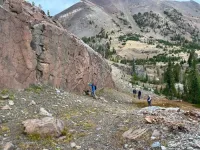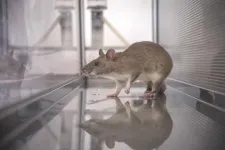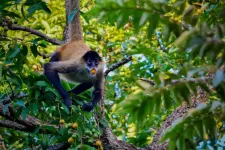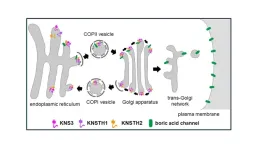(Press-News.org) An international team of geoscientists led by a volcanologist at Rutgers University-New Brunswick has discovered that, contrary to present scientific understanding, ancient volcanoes continued to spew carbon dioxide into the atmosphere from deep within the Earth long past their period of eruptions.
In doing so, the research team has solved a long-standing mystery over what caused prolonged episodes of warming during turning points in Earth’s climate history. The work is detailed in today’s issue of the journal Nature Geoscience.
“Our findings are important because they identify a hidden source of CO2 to the atmosphere during moments in Earth’s past when climate has warmed abruptly and stayed warm much longer than we expected,” said Benjamin Black, who led the study and is an associate professor in the Department of Earth and Planetary Sciences at the School of Arts and Sciences. “We think we have figured out an important piece of the puzzle for how Earth’s climate was disrupted, and perhaps just as importantly, how it recovered.”
In the present-day, humans are releasing vastly more carbon dioxide than all active volcanoes put together—but the new findings could shed light on how the planet’s climate will recover if and when human carbon dioxide emissions decrease. “Earth has natural climate control systems – sort of like the thermostat in your house,” Black said. “The question is—are there thresholds beyond which those climate control systems start to break down, making it much harder for climate to recover?”
For decades, scientists have been baffled by climate records showing the failure of the Earth’s atmosphere to recover as quickly as expected after what is known as the end-Permian mass extinction 252 million years ago – the most severe decrease in biodiversity known to have occurred on Earth. The mass extinction has been linked with tremendous volcanic eruptions in Siberia. Even after the eruptions ceased, Earth's climate took nearly 5 million years to stabilize.
“This delayed recovery has long puzzled scientists. Earth’s natural thermostat seems to have gone haywire during and after this event,” Black said. “We noticed that a similar pattern seemed to have occurred at multiple other times in Earth’s history with massive volcanism, and we set out to understand why.”
Black and an international team of colleagues looked back in time and found evidence for carbon dioxide emissions from this type of volcanic province that could last millions of years after most surface eruptions had ended. They did this by compiling chemical analyses of the lavas, developing computer models simulating melting inside the Earth, and comparing the results with records of past climate preserved in sedimentary rocks.
The analyses showed that massive ancient volcanic provinces shut down slowly. At the surface, eruptions may have stopped, but deep in the crust and mantle, magma was still releasing carbon dioxide, leading to prolonged climate warming.
“We call this CO2 from the subsurface magma ‘cryptic carbon’ because it comes from magmas lurking deep in the system,” Black said. “It’s as if the volcanoes were releasing carbon from beyond the grave.”
Black said the findings in the new study are significant because they identify a hidden source of atmospheric carbon dioxide during moments when the climate warmed abruptly. If the volcanoes kept “turning the temperature up,” it could mean the Earth’s thermostat may work better than scientists thought.
“If this is true, it could be good news for Earth's recovery after human-driven climate warming,” Black said. “It means that if we stop turning the thermostat up, on geologic timescales of hundreds of thousands to millions of years, climate can recover.”
Black emphasized that cryptic carbon from volcanoes cannot explain present-day climate change. “The type of volcanism we are investigating is rare, capable of generating enough magma to cover the continental United States half a kilometer deep in lava,” Black said. “This kind of volcanism has not occurred for 16 million years. All the volcanism taking place on the planet today releases less than one percent as much carbon dioxide as human activities.”
But scientists still hope to learn from these past eruptions about current and future climate. “These ancient eruptions appear to be some of the only events in Earth’s history that release carbon on the same scale as humans are doing today,” Black said. “So by studying these eruptions in the deep past we can learn more about how Earth’s climate systems respond to massive release of carbon to the atmosphere.”
These findings are just the beginning of a multi-year effort funded by the National Science Foundation to investigate how cryptic carbon could influence recovery after major disruptions of Earth’s climate. This summer, the team journeyed to northeastern Oregon, where massive volcanism has been linked with climate warming 16 million years ago. The scientists zeroed in the Wallowa Mountains, which are laced with enormous sheets of flat magmatic dikes, created when molten rock flowed into cracks and solidified. Because of erosion, the area known as the “Alps of Oregon” exposes these rocks that once constituted magma deep in the Earth.
Team members, including Black and colleagues and graduate students from Rutgers and other universities that are part of the National Science Foundation-funded team, clambered into the mountains, ranging between 5,000- and 9,000-feet high, and sampled the glass-like material at the edges of the dikes. These were created when magma came into contact with colder surrounding rocks. Back at their labs, the researchers are looking for evidence in the glassy rocks of ancient emissions of carbon dioxide and other gases.
Other scientists on the study included: Leif Karlstrom of the University of Oregon; Benjamin Mills of the University of Leeds, Leeds, UK; Tamsin Mather, University of Oxford, Oxford, UK; Maxwell Rudolph, University of California-Davis; Jack Longman, Northumbria University, Newcastle Upon Tyne, UK; and Andrew Merdith, University of Adelaide, Adelaide, Australia.
END
Buried Alive: Carbon dioxide release from magma deep beneath ancient volcanoes was a hidden driver of Earth’s past climate
A Rutgers-led study finds “cryptic carbon” from underground portions of enormous volcanic provinces contributed to climate warming during key moments in Earth’s past
2024-10-30
ELSE PRESS RELEASES FROM THIS DATE:
New genetic web tool to help restore climate-resilient marine ecosystems
2024-10-30
In the face of increased human pressures and climate change, a team of Australian scientists led by Dr Georgina Wood at Flinders University have launched a new online tool to assist marine managers and restoration experts to bolster the resilience of marine habitat-forming species.
The ‘Reef Adapt’ initiative, developed by experts from the NSW Department of Primary Industries and Regional Development (NSW DPIRD), Flinders University and The University of Western Australia (UWA), aims to expand the tools available to promote diverse, adaptable and resilient ecosystems.
Described in a new article in Communications Biology, Reef Adapt harnesses genetic data ...
Three pathways to achieve global climate and sustainable development goals
2024-10-30
"Sustainable development pathways are strategies that prevent dangerous climate change while at the same time moving towards a world that allows people to prosper on a healthy planet,” explains Bjoern Soergel, scientist at the Potsdam Institute for Climate Impact Research PIK and lead author of the study published in Environmental Research Letters. This is the essence of the 17 SDGs agreed by the United Nations in 2015. “Our analysis shows that all three sustainable development pathways are far more effective than our current ‘business as usual’. They drive substantial progress towards the SDGs, for example reducing the number of people in extreme poverty ...
Giant rats could soon fight illegal wildlife trade by sniffing out elephant tusk and rhino horn
2024-10-30
In the past, African giant pouched rats have learned to detect explosives and the tuberculosis-causing pathogen. Now, a team of researchers have trained these rats to pick up the scent of pangolin scales, elephant ivory, rhino horn, and African blackwood. These animals and plants are listed as threatened and at high danger of extinction.
“Our study shows that we can train African giant pouched rats to detect illegally trafficked wildlife, even when it has been concealed among other substances,” ...
Spin current observations from organic semiconductor side
2024-10-30
Electrons spin even without an electric charge and this motion in condensed matter constitutes spin current, which is attracting a great deal of attention for next-generation technology such as memory devices. An Osaka Metropolitan University-led research group has been able to gain further insight into this important topic in the field of spintronics.
To investigate the characteristics of spin currents, OMU Graduate School of Science Professor Katsuichi Kanemoto’s group designed a multilayer device consisting of a ferromagnetic layer and an organic semiconductor ...
Alcohol consumption among non-human animals may not be as rare as previously thought, say ecologists
2024-10-30
Anecdotes abound of wildlife behaving “drunk” after eating fermented fruits, but despite this, nonhuman consumption of ethanol has been assumed to be rare and accidental. Ecologists challenge this assumption in a review publishing October 30 in the Cell Press journal Trends in Ecology & Evolution. They argue that since ethanol is naturally present in nearly every ecosystem, it is likely consumed on a regular basis by most fruit- and nectar-eating animals.
“We're moving away from this anthropocentric view that ethanol is just something ...
Survey: Dangerous gap in knowledge about pancreatic cancer among adults under age 50
2024-10-30
While pancreatic cancer rates are rising in people under age 50, a new survey conducted by The Ohio State University Comprehensive Cancer Center – Arthur G. James Cancer Hospital and Richard J. Solove Research Institute (OSUCCC – James) shows most people continue to believe that pancreatic disease affects only the elderly – and that there is nothing they can do to reduce their risk.
For this survey, respondents were asked about risk factors for pancreatic cancer. More than half (53%) of adults under age 50 said they would not recognize the early signs or symptoms of the disease, and more than one third (37%) believe there is ...
Women entering menopause later in life at greater risk for asthma
2024-10-30
CLEVELAND, Ohio (Oct. 30, 2024)—Many studies suggest that an earlier age at menopause is more detrimental to a woman’s health, leading to an increased risk for adverse health conditions such as heart disease, diabetes, osteoporosis, and depression, among others. However, a new study is linking a later age at natural menopause with a greater risk for asthma. Results of the study are published online today in Menopause, the journal of The Menopause Society.
Asthma is a common, chronic disease affecting more than 300 million people worldwide. The prevalence of asthma ...
Sinuses prevented prehistoric croc relatives from deep diving
2024-10-30
EMBARGOED: NOT FOR RELEASE UNTIL 00.05 (UK TIME) WEDNESDAY 30 OCTOBER 2024
An international team of paleobiologists have found that the sinuses of ocean dwelling relatives of modern-day crocodiles prevented them from evolving into deep divers like whales and dolphins.
A new paper published today [30 October] in Royal Society Open Science suggests that thalattosuchians, which lived at the time of the dinosaurs, were stopped from exploring the deep due to their large snout sinuses.
Whales and dolphins (cetaceans) ...
Spirited away: Key protein aids transport within plant cells
2024-10-30
Botanists have come to understand the channels and transporters involved in the uptake and transport of nutrients, yet how are they positioned where they need to be?
For example, plants need boron, which is taken into the cells by molecules known as the boric acid channel. But how do the proteins that form the channel make it to the plasma membrane?
A research group led by Professor Junpei Takano of Osaka Metropolitan University’s Graduate School of Agriculture identified a mutant line of Arabidopsis thaliana in which the boric acid channels are not properly transported to the plasma membrane. The cause was a deficiency in the protein KAONASHI3 (KNS3); the name ...
Britain’s brass bands older than we thought and invented by soldiers from the Napoleonic Wars, new study reveals
2024-10-30
University of Cambridge media release
Britain’s brass bands older than we thought and invented by soldiers from the Napoleonic Wars, new study reveals
UNDER STRICT EMBARGO UNTIL 00:01 AM (UK TIME) ON WEDNESDAY 30TH OCTOBER 2024
Military musicians returning from the Napoleonic wars established Britain’s first brass bands earlier than previously thought, new research reveals. The study undermines the idea that brass bands were a civilian and exclusively northern creation.
It is widely believed that brass bands originated with coal miners and other industrial communities ...
LAST 30 PRESS RELEASES:
Blocking a key inflammatory pathway improves liver structure and vascular function in cirrhosis, study finds
Continuous spread: Raccoon roundworm detected in nine European countries
HKUST Engineering researchers developed a novel photodetector to enhance the performance of on-chip light monitoring
Strategic river sensors could have forewarned of Texas Camp flood disaster
Drone sampling of whale breath reveals first evidence of potentially deadly virus in Arctic
Roman soldiers defending Hadrian’s Wall infected by parasites, study finds
Pinochet’s prisoners were tormented with music but still found solace in it, a new book reveals
Fertility remains high in rural Tanzania despite access to family planning
AI-assisted device can improve autism care access
Kinetic careers
Uncovering how parasitic plants avoid attacking themselves to improve crop resistance
Nanoparticle vaccine strategy could protect against Ebola and other deadly filoviruses
Study finds brain care score can predict risk of stroke across racial groups
Key lung immune cells can intensify allergic reactions
Do hormones explain why women experience more gut pain?
New materials conduct ions in solids as easily as in liquids
Breakthrough of the Year: Renewable energy begins to eclipse fossil fuel-based sources
LLM use is reshaping scientific enterprise by increasing output, reducing quality and more
Introducing LightGen, a chip for ultra-fast, ultra-efficient generative AI
Astronomers see fireworks from violent collisions around nearby star
ACC/AHA issue new guideline on managing congenital heart disease in adults
Cosmic crash caught on camera
Is talented youth nurtured the wrong way? New study shows: top performers develop differently than assumed
Ants: An untapped resource in the development of antibiotics?
Archaeologists use AI to create prehistoric video game
Mitochondria migrate toward the cell membrane in response to high glucose levels
Tiny viral switch offers hope against drug-resistant bacteria
Most parents aware of early peanut introduction guidelines, but confused about details
HPV vaccine can protect against severe lesions of the vulva and vagina
Virtual care provision and emergency department use among children and youth
[Press-News.org] Buried Alive: Carbon dioxide release from magma deep beneath ancient volcanoes was a hidden driver of Earth’s past climateA Rutgers-led study finds “cryptic carbon” from underground portions of enormous volcanic provinces contributed to climate warming during key moments in Earth’s past







